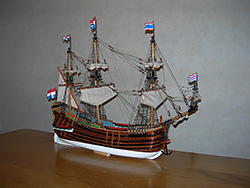whalers
17th century whaler
Not an antique
SOLD
Fishery at 79 degrees north latitude
The discovery of Mr. Willem Barentz in 1597 to find the northeast passage failed and ended with a winter spent in Nova Zembla.
However, it was discovered that the area was swarming with whales and that brought in the 17th century a thriving industry. On the island Amsterdam, in northwestern Spitsbergen a small village of about 250 inhabitants came into existence, called Smeerenburg, where the whales were processed.
 They used the ordinary cargo ships of the time, called “fluiten”. These ships had the, for those days unusual, length/width ratio of about 4 to 1. The rig was simple so they could sail with a relatively small crew. For this work they were slightly modified with a bar on the stern which boats could be hung. The sides were reinforced with beams for that purpose and on deck was an extra heavy capstan.
They used the ordinary cargo ships of the time, called “fluiten”. These ships had the, for those days unusual, length/width ratio of about 4 to 1. The rig was simple so they could sail with a relatively small crew. For this work they were slightly modified with a bar on the stern which boats could be hung. The sides were reinforced with beams for that purpose and on deck was an extra heavy capstan.
The hunting of whales in Spitsbergen has had its heyday between 1610 and 1670. Thereafter, the fishery decreased rapidly due to overfishing.
Contact us for more information





